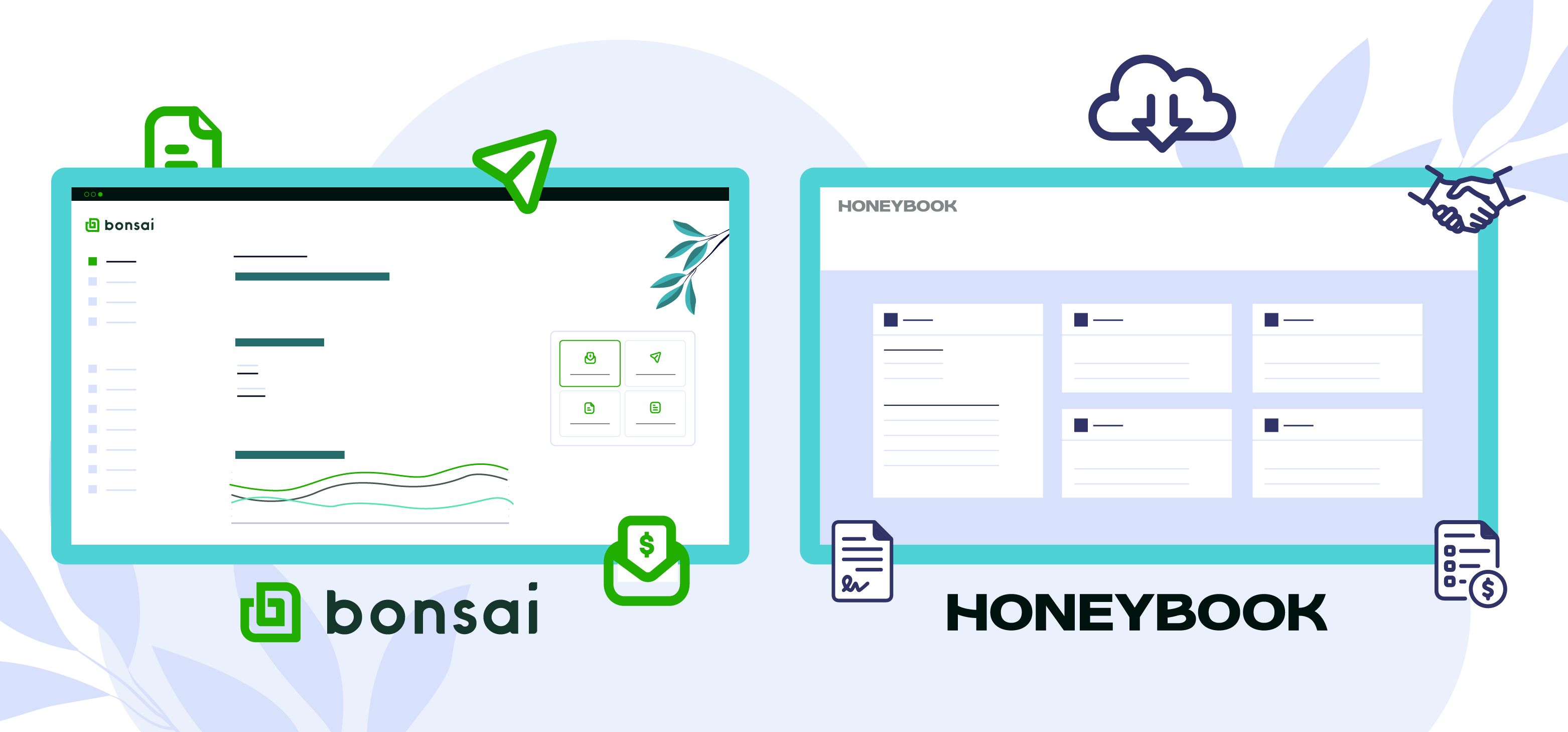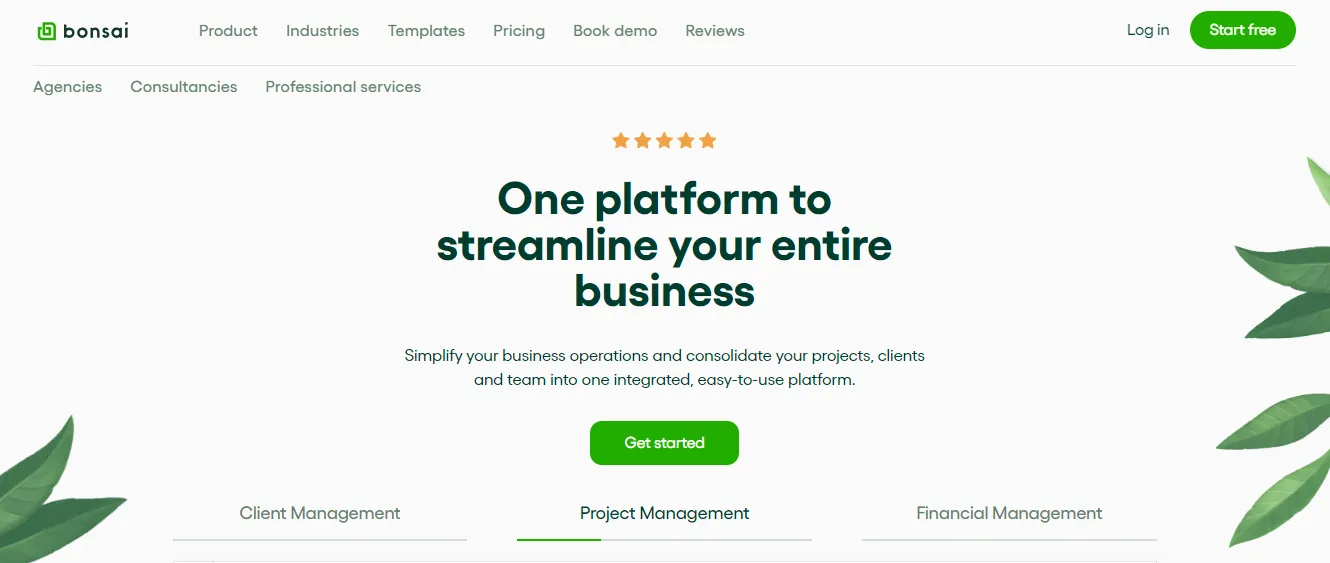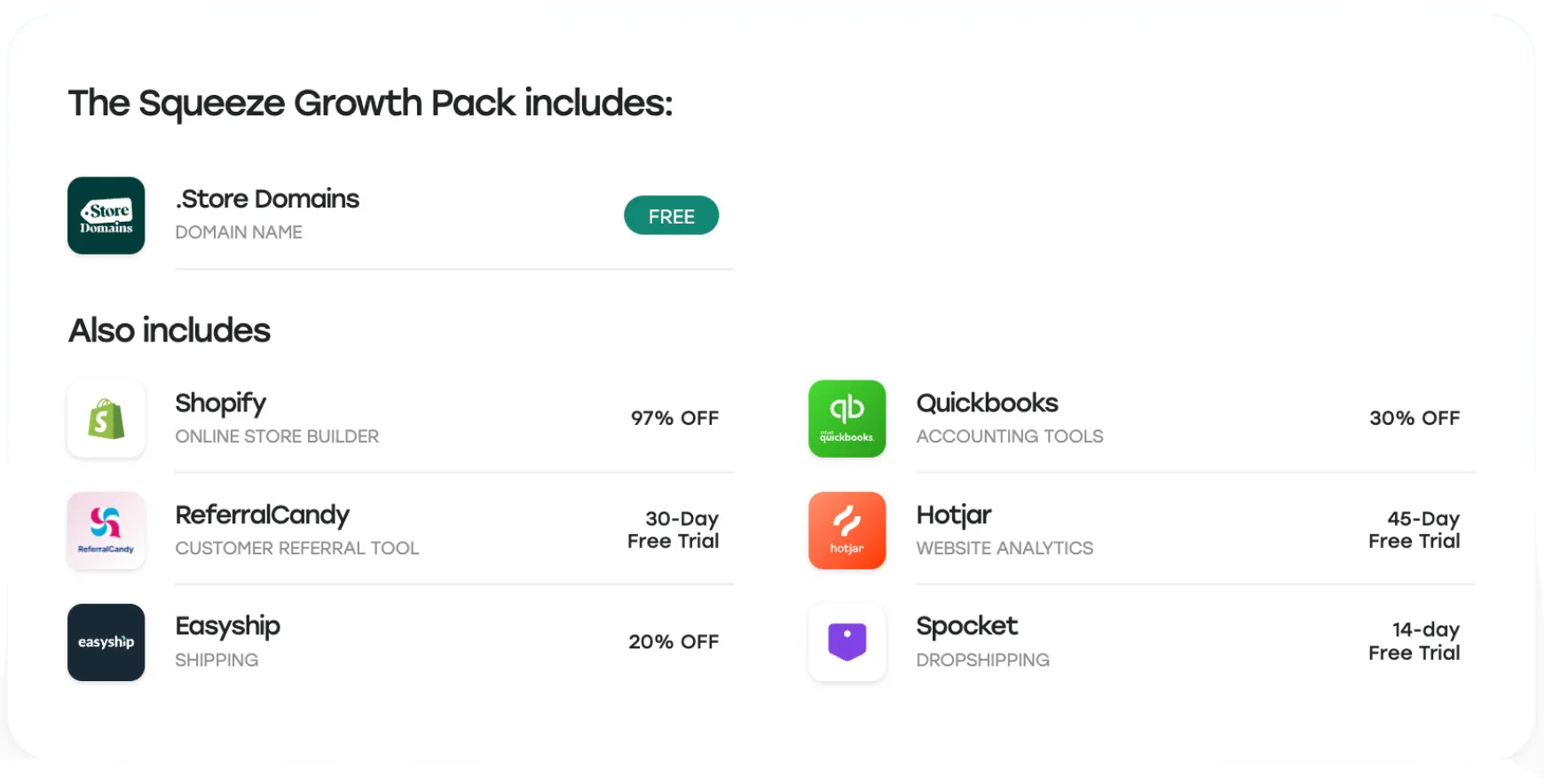
Bonsai and HoneyBook are the best client management platforms for independent contractors. They enable you to handle multiple clients with ease and provide you with tools to streamline your workflows.
Whether it’s a proposal creation, project tracking, or invoice processing, you can manage almost everything via these applications.
In this article, I have made Bonsai and HoneyBook feature comparison. Here, you’ll discover their core functions and pricing packages to make a well-informed purchase decision.
Let’s start with the product summary.
Bonsai Overview

Bonsai is a cloud-based software product that delivers client management tools to small businesses. Freelancers, consultants, and agencies can use it to centralize client communication and keep track of potential and ongoing projects.
With Bonsai, you can send proposals, create projects, collaborate with clients, and get paid. You’ll receive standard templates for documentation and automation tools to expedite your processes.
Bonsai also provides a digital wallet to receive payments and manage expenses.
Over 500,000 professionals have signed up to Bonsai for business management.
Core Features of Bonsai
- Clients and projects.
- Proposals and contracts.
- Invoices and payments.
- Project management.
- Expense and tax tracking.
- Team collaboration.
- Integrations.
Bonsai gives you the flexibility to purchase monthly or yearly subscriptions with a 14-day refund option.
You can try the app for free and change your plan anytime. Here’s the link to the official site.
HoneyBook Overview

Like Bonsai, HoneyBook is a client management app. It allows you to create contracts and invoices, process client payments, manage multiple tasks, and work with your team.
You’ll receive several scheduling and productivity tools to set your workflows on autopilot and a CRM to manage client relationships. Via the financial module, you can process online transactions and accept credit card payments.
Using HoneyBook templates, you can save a lot of time and optimize your client communication.
Whether you are a freelancer, an event planner, or a marketing agency, you can use this app to manage your business.
Core Features of HoneyBook
- Clients and projects.
- Template library.
- Project management and CRM.
- Scheduling and automation.
- Team collaboration.
- Invoices and payments.
- Integrations.
HoneyBook offers both monthly and annual subscriptions with free trials. You can upgrade or downgrade your plan anytime.
For more details, check out its official site.
Bonsai Vs HoneyBook—Feature Comparison
Bonsai and HoneyBook offer productivity and finance tools to organize work and improve client experience.
Via these apps, you can easily manage your time, projects, and payments, eliminating the need for manual tracking.
Below, I have reviewed Bonsai and HoneyBook’s three main functions. I have compared their essential features to highlight their core capabilities.
1. Client Management
Client management typically involves lead generation, proposals, projects, and contracts.
The software comes with CRM and promotion tools to help you connect with prospective customers and finalize the deals.
Here’s the summary of Bonsai and HoneyBook’s client management module.
Bonsai Client Management

Bonsai provides a digital space to manage leads and existing clients.
Here, you’ll receive an integrated appointment system with package templates to set up a professional booking page on your website. You can easily synchronize your calendars to eliminate double appointments and create professional proposals to win clients.
Via Bonsai CRM, you can create client profiles and track proposals to ensure you don’t miss anything. You can add little notes and contact details inside each profile to organize all the information.
With email integration, you can automate reminders, confirmations, and notifications.
Top Client Management Features of Bonsai;
- Embedded Booking page.
- Unlimited client profiles.
- Proposals and contracts.
- E-signature.
- Reminders and tracking.
- Calendar integration.
HoneyBook Client Management

HoneyBook client’s management features are almost similar to that of Bonsai’s.
You’ll get calendar integration to manage availability and workspaces for project pipelines and communication. You can create as many client profiles as you want and embed contact forms into your website to capture more leads.
HoneyBook also provides a Google Extension to track leads. You can use client workspace for both potential and existing customers and set up email follow-ups to optimize your communication.
Top Client Management Features of HoneyBook;
- Service brochures.
- Contact forms.
- Calendar booking.
- Proposals and contracts.
- E-signatures.
- Client workspace.
- Email integration.
- Auto-notifications and reminders.
Verdict
Both Bonsai and HoneyBook enable you to showcase your services, set up appointments, and manage leads and existing clients.
There are a few areas where Bonsai might have an edge over HoneyBook. For instance, you can oversee multiple companies in both apps, but Bonsai allows you to use your account as a contractor and client.
You can toggle between contractor and client mode from one account.
2. Project Management
Bonsai and HoneyBook provide several project features to work with clients and keep track of your tasks.
This includes time management, client collaboration, file sharing, and data storage.
Here’s the summary of their project modules.
Bonsai Project Management

Bonsai delivers a kanban board and time-tracking tools to create projects and oversee your ongoing work.
You will be able to set up estimated budgets, tag tasks by priority, record billable hours, and generate timesheets. Both you and your clients will get digital portals to communicate and share relevant information with each other.
If you run a growing business with a dedicated team, you can add them to your account. Your staff can access their accounts via their mobile phones or web browsers, and log on and off anytime.
With Bonsai insights, you can easily track your team’s performance and measure your project profitability.
Top Project Management Features of Bonsai;
- Task creation.
- Kanban board.
- File sharing.
- Time tracking.
- Collaboration.
- Client portal.
- Mobile apps.
HoneyBook Project Management

HoneyBook project features include task creation, time tracking, communication automation, and team collaboration.
The software is easy to navigate and comes with trigger automation to eliminate back-and-forth communication. You can create your task do-lists to keep track of upcoming and existing projects and set up reminders to get alerts when they are due.
Using pipelines, notifications, and integrations, you can keep an eye on your work and take timely action.
Top Project Management Features of HoneyBook;
- To-do lists and tasks.
- Team collaboration.
- Pipeline.
- Automation.
- Sharingand communication.
- Client portal.
- Mobile apps.
Verdict
Both Bonsai and HoneyBook have essential project management tools. You can build projects, track time, assign tasks, and invite clients.
However, Bonsai’s tracking and reporting appear to be comparatively advanced. The app also has additional features for teams to help agencies work with subcontractors.
3. Payment Workflows
Bonsai and HoneyBook both have payment processing capabilities.
They deliver user-friendly invoicing generation tools and allow banks and credit card transactions for expenses and client payments.
Here’s a summary of their payment features.
Bonsai Invoices and Payments

Bonsai’s finance module covers several areas.
You can create invoices, set up recurring payments, process global transactions, and manage taxes. The app delivers a business account for transactions and bookkeeping tools to keep an eye on your profit and loss.
You can directly convert your and your team’s billable hours into invoices and provide flexible payment gateways to your client. You’ll also get a diverse range of invoice templates to build tailored content.
Top Finance Features of Bonsai;
- Templates and customization.
- Recurring invoices with automation.
- Flexible payment options, including PayPal.
- Bookkeeping tools.
- Tax add-ons.
- Business account.
HoneyBook Invoices and Payments

HoneyBook enables you to generate quick invoices from your mobile phones and automate your payment workflows.
You will receive some invoice templates to get started and automation tools to set your invoicing process on autopilot. Your clients can open invoices from any device to pay and send bonuses or tips with the payments.
With the audit trail, you can see outstanding invoices and track your payments.
Top Finance Features of HoneyBook;
- Invoice generation.
- Templates.
- Recurring payments.
- Secure transactions.
- Auto-pay.
- Reminders and tracking.
- Fraud protection.
Verdict
Bonsai finance module has more features comparatively.
You can offer flexible payment options to your clients and let them pay the transaction fees. If you work with international clients, you can process global payments in 100+ currencies.
Bonsai also has an instant payout method for US transactions. By enabling it, you can receive payments within an hour.
HoneyBook, on the other hand, provides payment security. If your business is within the US, HoneyBook is an ideal option.
Third-Party Integrations and Devices
Bonsai and HoneyBook deliver mobile apps and browser extensions for easy accessibility. You can comfortably track time and manage invoices from your iOS and Android apps.
You’ll additionally get a third-party integration option to synchronize your workflows.
For instance, you can link your calendars for availability management, integrate Gmail for communication, and connect other popular productivity tools.
Here’s the list of applications Bonsai and HoneyBook support.
Top Bonsai Integrations;

- Gmail.
- QuickBooks.
- Calendly.
- Slack.
- Zoom.
- Zapier.
Top HoneyBook Integrations;

- Gmail.
- Zoom.
- QuickBooks.
- Calendly.
- Outlook.
- Zapier.
Verdict
Bonsai and HoneyBook’s integration lists are more or less the same. Even if they weren’t, you can connect with tons of third-party tools with Zapier integration.
Both also support mobile devices, which makes them convenient and accessible.
Prices
Bonsai sells core packages with optional add-ons for extended functionality.
You can purchase a monthly subscription and take a 7-day free trial, or go for the annual package and get two months free.
HoneyBook also sells three packages with a 60-day refund option. All plans support monthly and annual subscriptions with a 7-day free trial for software testing.
HoneyBook is also running a discount campaign at the moment, offering up to 50% off for the first three months. If you can’t see it, the promotion might have ended.
Here’s their package summary.
Bonsai Prices

Starter: It costs $25 per month, and $21 on the annual plan. The package contains unlimited projects, templates, CRM, and expense tracking.
Professional: It costs $39 per month, and $32 on the annual plan. You’ll get everything from the starter plan, plus some integrations.
Business: It’s specifically designed for agencies, costing $79 per month. If you purchase the annual plan, you’ll be charged $66 per month.
Add-Ons: Bonsai offers team collaboration and tax management as an add-on service. The prices start from $10.
HoneyBook Prices

Starter: The original rate is $19 per month, and the discounted price is $10. The package includes unlimited projects, a client portal, templates, and reports.
Essential: The original rate is $39, and the discounted price is $20. The package contains all the features of the starter plan and some premium features.
Premium: The original rate is $70, and the discounted price is $40. You’ll get everything with priority support.
Pros: HoneyBook hosts a marketplace of independent experts for product setup and work optimization.
Verdict
Bonsai and HoneyBook follow the same pricing model, but their package details and rates vary slightly.
For instance. HoneyBook is more affordable, but Bonsai has extra essential tools in its basic plan.
Based on their prices, HoneyBook appears to be the best option.
Pros And Cons
As client management apps, Bonsai and HoneyBook are both good options. You can pick any of the two to simplify your operations and process payments.
To make the best choice, however, you should explore the app’s flexibility and limitations. It may help you decide the suitability of the product.
Here are some key pros and cons of Bonsai and HoneyBook for comparison.

Bonsai Pros
- Excellent time-tracking tools.
- Business account and global payments support.
- Additional features for agencies.
Bonsai Cons
- Comparatively expensive.
- Customer care response might be slow.
HoneyBook Pros
- Attractive packages.
- A free team feature in core packages.
- AI composer.
HoneyBook Cons
- A few options for international clients.
- Limited customization.
- For more details, you can book a demo or reach out to the contact center.
Verdict
Bonsai and HoneyBook’s integration lists are more or less the same. Even if they weren’t, you can connect with tons of third-party tools with Zapier integration.
Both also support mobile devices, which makes them convenient and accessible.
Conclusion
Bonsai and HoneyBook are comprehensive client management platforms. They are designed to make things easier for small contractors, delivering essential tech to run a successful business.
If you compare their package prices, HoneyBook appears to be a better option for freelancers. But Bonsai is equally an excellent tool and has, in fact, a larger client base. You might want to consider that before choosing any of them.
I recommend taking their free trial to explore the software products before making a final decision. Good luck!


